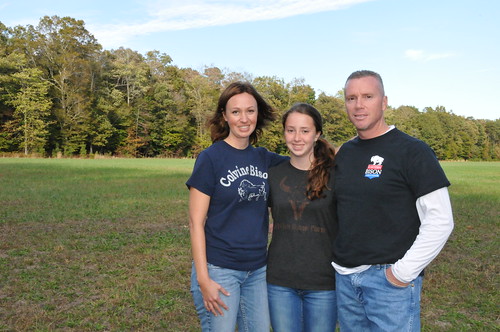
Bison farmers Bobbi and Allen with their daughter in front of the family-run farm. Photo: Dastina Wallace.
Bison farmer Bobbi Lester cares for the land with just as much passion and love as her father. As a little girl growing up on the ranch in southern Delaware, she remembers learning the ropes of bison farming, often traveling with him to regional and national bison conferences. When Bobbi Lester’s father, Robert Collins, lost his battle to cancer in 2012, Bobbi, along with her husband Allen, stepped up to continue farming the way he would have wanted—as a family.
Bobbi recalls how her dad started with just three heifers and a bull on 88 acres in Greenwood, Delaware, and grew into the herd of 65 bison.
“Because of the bison’s population decline 30 years ago, Collins originally planned to breed the bison,” said Bobbi.
As a result of many approaches to conservation and stewardship of bison, including the creation of small herds by private ranchers, bison populations have rebounded in recent years and population decline is no longer a concern.
Now, the Lester farm provides bison meat to local consumers. Raising bison has taught the family some important lessons in sustainability and conservation.
As herd animals, bison make an impact on the land wherever they go. Bobbi’s dad began working with the USDA Natural Resources Conservation Service (NRCS) in 2008 on practices that would help him address resource concerns and while also achieving the goal of operational viability.
Collin’s commitment to the health of the animals and sustainability of the operation improved the way the farm was managed, benefiting Collins and built a legacy for the next generation. Using theEnvironmental Quality Incentives Program, financial and technical assistance was provided for regrading and seeding some swales with plants to stabilize highly disturbed and critical areas. NRCS was also able to assist the family as they added cross fencing, reseeded pastures, implemented prescribed grazing practices, and improved forage management and watering facilities.
“Before NRCS, we had water troughs and bathtubs of water for the bison. My dad and oldest sister, Wanda, would have to carry out hot buckets of water to unfreeze the water. Bobbi said. “Now we have heaters.”
She continues, “And then in summer, we had algae growth and had to remove that to get the water where it was drinkable. That’s no longer the case.”
Bobbi and Allen continue to work with NRCS implementing new practices as their needs change.
“Our watering facility is imperative because bison come up as a herd to get water. If the last bison in a herd comes up to drink and doesn’t have water available, he doesn’t get a drink because the herd will move on together.”
“It was great to learn the proper way to rotationally graze in order to extend the life of the pasture,” said Bobbi. “You would think that when grass is gone, you rotate animals, but NRCS Soil Conservationist Bobby Gorski told us about grazing only to a certain height on the pastures to avoid ruining the area.”
“Good pasture management is everything. Over graze and your fields won’t grow back,” she said.
Because of their reseeding practice the Lesters have more hay, which has significantly reduced the amount of feed and grain they have to purchase. “It was life changing. We can keep them in the pasture all year and supplement their feeding with hay once it starts snowing,” said Bobbi.
Bobbi and her family are reminded daily of the critical conservation steps that her dad took to ensure the sustainability of the farm, and it is evident today in how they operate this second-generation farm.
Farmers interested in learning more about land management practices should visitwww.nrcs.usda.gov/GetStarted or a local USDA service center.
Since 2009, USDA has invested more than $29 billion to help producers make conservation improvements, working with as many as 500,000 farmers, ranchers and landowners to protect over 400 million acres nationwide, boosting soil and air quality, cleaning and conserving water and enhancing wildlife habitat. For an interactive look at USDA’s work in conservation and forestry over the course of this Administration, visit https://medium.com/usda-results.

Lester family shows off their reseeded pasture in the background, which allows them to get more hay. Photo: Dastina Wallace.
No comments:
Post a Comment
Note: Only a member of this blog may post a comment.